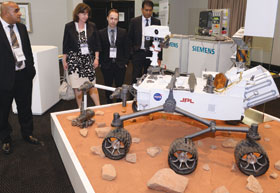

It’s a long way from the red planet to the East Rand, but the Curiosity Mars Rover landed at the Birchwood hotel recently as part of the Siemens’ Future of Manufacturing event. The Siemens’ Curiosity model travels the world to demonstrate how the complex robot was put together, tested and operates day to day – largely using the global engineering firm’s software.
It is known across the world as the robot exploring Mars, but very little is known about the extensive simulation and testing processes on earth that make planetary exploration possible. Its construction had to be perfect to take every risk into account. This includes the design of all 90 000 parts that work together inside the Rover, the complex entry and landing sequence on the Martian surface, as well as the robot’s survival in the harsh Martian environment.
Just one shot on Mars
“We don’t get a chance to try again, we have one shot and it’s usually doing something we’ve never done before,” says Bill Allen, mechanical design engineer at NASA’s Jet Propulsion Laboratory (JPL) in California.
JPL used Siemens computer-aided engineering software to test and simulate how the thousands of parts would work together and how much stress they could take from temperature, friction and pressure changes. Siemens NX programs were also used to generate the code which guided the machines manufacturing the intricate Mars Rover parts to within the accuracy of the width of a human hair. The environment in space is impossible to recreate on earth, so simulation software was also essential. Curiosity was put through the vacuum and extreme cold of deep space, was then re-pressurised in the Martian atmosphere, experienced extreme wind, vibration, noise and G-forces, and then scorching heat and freezing cold – all within hours.
Curiosity’s landing sequence alone was perfected through 8000 simulations. On the day of the Mars landing, NASA only had one shot at the Sky Crane setting down its prized Mars Science Laboratory. Internally, these are referred to as NASA’s seven minutes of terror, and it is one of the great triumphs for the agency.
Even now, Curiosity does not make a move on Mars without it being tested or simulated in some way. An Earth-bound twin, identical except for the nuclear power source, is used at the Mars Yard at JPL to tackle obstacles for its sibling – simulation on earth to spare a Curiosity failure on Mars.
For more information contact Keshin Govender, Siemens Southern Africa, +27 (0)11 652 2412, [email protected], www.siemens.co.za
| Tel: | +27 11 652 2000 |
| Email: | [email protected] |
| www: | www.siemens.co.za |
| Articles: | More information and articles about Siemens South Africa |

© Technews Publishing (Pty) Ltd | All Rights Reserved